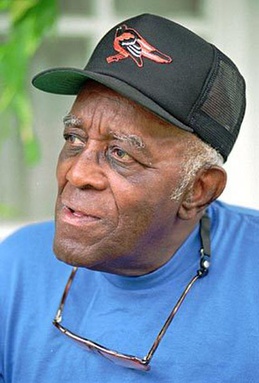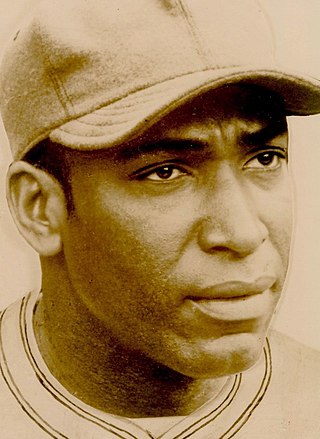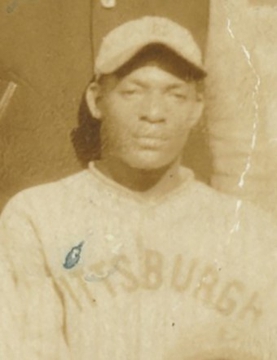
Leroy Robert "Satchel" Paige was an American professional baseball pitcher who played in Negro league baseball and Major League Baseball (MLB). His career spanned five decades and culminated with his induction into the National Baseball Hall of Fame.
The Negro leagues were United States professional baseball leagues comprising teams of African Americans. The term may be used broadly to include professional black teams outside the leagues and it may be used narrowly for the seven relatively successful leagues beginning in 1920 that are sometimes termed "Negro Major Leagues".

James Thomas "Cool Papa" Bell was an American center fielder in Negro league baseball from 1922 to 1946. He is considered to have been one of the fastest men ever to play the game. He was elected to the Baseball Hall of Fame in 1974. He ranked 66th on a list of the greatest baseball players published by The Sporting News in 1999.

Leon Day was an American professional baseball pitcher who spent the majority of his career in the Negro leagues. Recognized as one of the most versatile athletes in the league during his prime, Day could play every position, with the exception of catcher, and often was the starting second baseman or center fielder when he was not on the mound. A right-handed pitcher with a trademark no wind-up delivery, Day excelled at striking batters out, especially with his high-speed fastball. At the same time, he was an above-average contact hitter, which, combined with his effectiveness as a baserunner and his tenacious fielding, helped cement Day as one of the most dynamic players of the era.

William Hendrick Foster was an American left-handed pitcher in baseball's Negro leagues in the 1920s and 1930s, and had a career record of 110–56. He was elected to the Baseball Hall of Fame in 1996. Foster was the much-younger half-brother of Rube Foster, a Negro league player, pioneer, and fellow Hall of Famer.

The Kansas City Monarchs were the longest-running franchise in the history of baseball's Negro leagues. Operating in Kansas City, Missouri, and owned by J. L. Wilkinson, they were charter members of the Negro National League from 1920 to 1930. J. L. Wilkinson was the first white owner at the time of the establishment of the team. In 1930, the Monarchs became the first professional baseball team to use a portable lighting system which was transported from game to game in trucks to play games at night, five years before any MLB team did. The Monarchs won ten league championships before integration, and triumphed in the first Negro League World Series in 1924. The Monarchs had only one season in which they did not have a winning record. The team produced more major league players than any other Negro league franchise. It was disbanded in 1965.

Martín Magdaleno Dihigo Llanos, called The Immortal and The Maestro, was a Cuban professional baseball player. He played in the Negro leagues and Latin American leagues from 1923 to 1936 as a two-way player, both as a pitcher and a second baseman, although he excelled at all nine positions and later as a manager.

Wilber Joe Rogan, also known as "Bullet Joe", was an American pitcher, outfielder, and manager for the Kansas City Monarchs in the Negro baseball leagues from 1920 to 1938. Renowned as a two-way player who could both hit and pitch successfully, one statistical compilation shows Rogan winning more games than any other pitcher in Negro leagues history and ranking fourth highest in career batting average. He was elected to the Baseball Hall of Fame in 1998.

Hilton Lee Smith was an American right-handed pitcher in Negro league baseball. He pitched alongside Satchel Paige for the Kansas City Monarchs and Bismarck Churchills between 1932 and 1948. He was inducted into the National Baseball Hall of Fame in 2001.

The Birmingham Black Barons were a Negro league baseball team that played from 1920 until 1960. They shared their home field of Rickwood Field in Birmingham, Alabama, with the white Birmingham Barons, usually drawing larger crowds and equal press.

The East–West All-Star Game was an annual all-star game for Negro league baseball players. The game was the brainchild of Gus Greenlee, owner of the Pittsburgh Crawfords. In 1933 he decided to emulate the Major League Baseball All-Star Game, using Negro league players. Newspaper balloting was set up to allow the fans to choose the starting lineups for that first game, a tradition that continued through the series' end in 1962. Unlike the white All-Star game which is played near the middle of the season, the Negro All-Star game was held toward the end of the season.
The Bismarck team was an integrated semi-professional baseball team based in Bismarck, North Dakota, in the 1930s. The team played independently of any league because its mixed-race roster was a problem in a period of segregation, and because there were no formal leagues at the semi-professional level in North Dakota in the 1930s. The team was owned by Neil Churchill, a local car dealer who owned the city's Chrysler dealership, and regularly played against Valley City, Jamestown, and other teams across North Dakota and Manitoba.
The 1942 Negro World Series was a best-of-seven match-up between the Negro American League champion Kansas City Monarchs and the Negro National League champion Washington-Homestead Grays. In a six-game series, the Monarchs swept the Grays four games to none, with two additional games not counted in the standings. The Monarchs actually won the 1942 series 5-1, but a second game played in Yankee Stadium on September 13 was not counted by prior agreement, and the only game played in Kansas City was thrown out on appeal when the Grays used unauthorized players from other NNL teams.
California Winter League is a former baseball winter league. It was the first integrated league in the 20th century as players from Major League Baseball and Negro league baseball played each other in training games. The league was in existence from the turn of the 20th century to 1947.
The 1948 Cleveland Indians season was the 48th in franchise history. When the regular season resulted in a first place tie, the Indians won a one-game playoff against the Boston Red Sox to advance to the World Series. Cleveland won the championship by defeating the Boston Braves 4 games to 2 for their first World Series win in 28 years. The Sporting News ranked the 1948 Indians the ninth-best team ever.
The Mobile Tigers, a semi-professional baseball team composed entirely of African-American players based in Mobile, Alabama. It was one of several Black baseball teams based in Mobile during the same period and was a training ground for at least three players who later joined the Negro leagues.
The East–West League was an American Negro baseball league that operated during the period when professional baseball in the United States was segregated. Cum Posey organized the league in 1932, but it did not last the full year and folded in June of that year. It was the first Negro league to include teams from both the Eastern and Midwestern United States.
The Negro Southern League (NSL) was one of the several Negro baseball leagues created during the time organized baseball was segregated. The NSL was organized as a minor league in 1920 and lasted until 1936. It was considered a major league for the 1932 season and it was also the only organized league to finish its full schedule that season. Prior to the season, several established teams joined the NSL, mainly from the collapsed Negro National League.

William Gamiel Perkins was an American baseball catcher from who played in the Negro leagues from 1928 to 1948 with several teams.
Andrew "Andy" Anderson was an American baseball player in the Negro leagues. He served as a catcher for Satchel Paige in 1927 with the Chattanooga Black Lookouts. Anderson worked as a musician and spent 20 years in the Negro leagues. He played for a number of teams including the Mohawk Giants and Syracuse Black Chiefs. Anderson died in 1989.











